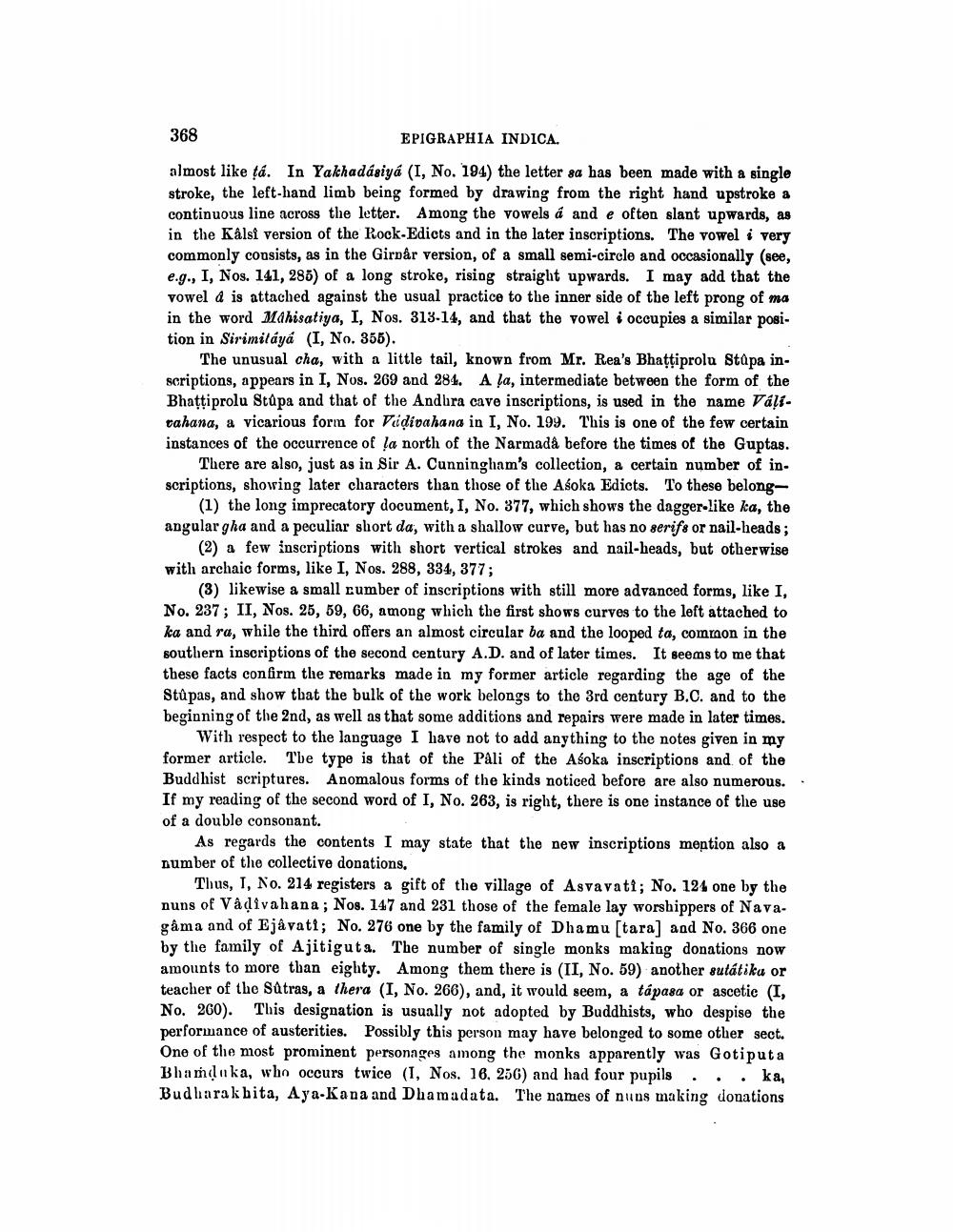________________
368
EPIGRAPHIA INDICA.
almost like ţa. In Yakhadásiya (I, No. 194) the letter sa has been made with a single stroke, the left-hand limb being formed by drawing from the right hand upstroke a continuous line across the letter. Among the vowels á and e often slant upwards, as in the Kålsi version of the Rock-Edicts and in the later inscriptions. The vowel i very commonly consists, as in the Girpår version, of a small semi-circle and occasionally (see, e.g., I, Nos. 141, 286) of a long stroke, rising straight upwards. I may add that the vowel d is attached against the usual practice to the inner side of the left prong of ma in the word Mahisatiya, I, Nos. 313-14, and that the vowel i occupies a similar position in Sirimiláyá (I, No. 355).
The unusual cha, with a little tail, known from Mr. Rea's Bhattiprolu Stupa inscriptions, appears in I, Nos. 269 and 284. A la, intermediate between the form of the Bhattiprolu Stupa and that of the Andhra cave inscriptions, is used in the name Váļi. cahana, a vicarious form for Vidivahana in I, No. 199. This is one of the few certain instances of the occurrence of la north of the Narmada before the times of the Guptas.
There are also, just as in Sir A. Cunningham's collection, a certain number of inscriptions, showing later characters than those of the Asoka Edicts. To these belong
(1) the long imprecatory document, I, No. 377, which shows the dagger-like ka, the angular gha and a peculiar short da, with a shallow curve, but has no serifs or nail-heads;
(2) a few inscriptions with short vertical strokes and nail-heads, but otherwise with archaic forms, like I, Nos. 288, 334, 377;
(3) likewise a small number of inscriptions with still more advanced forms, like I, No. 237; II, Nos. 25, 59, 66, among which the first shows curves to the left attached to ka and ra, while the third offers an almost circular ba and the looped ta, common in the southern inscriptions of the second century A.D. and of later times. It seems to me that these facts confirm the remarks made in my former article regarding the age of the Stúpas, and show that the bulk of the work belongs to the 3rd century B.C. and to the beginning of the 2nd, as well as that some additions and repairs were made in later times.
With respect to the language I have not to add anything to the notes given in my former article. The type is that of the Pali of the Asoka inscriptions and of the Buddhist scriptures. Anomalous forms of the kinds noticed before are also numerous. If my reading of the second word of I, No. 263, is right, there is one instance of the use of a double consonant.
As regards the contents I may state that the new inscriptions mention also a number of the collective donations,
Thus, I, No. 214 registers a gift of the village of Asvavati; No. 124 one by the nuns of Vadivahana ; Nos. 147 and 231 those of the female lay worshippers of Nava. gâma and of Ejavati; No. 276 one by the family of Dhamu [tara) and No. 366 one by the family of Ajitiguta. The number of single monks making donations now amounts to more than eighty. Among them there is (II, No. 59) another sutátiku or teacher of the Satras, a thera (I, No. 266), and, it would seem, a tápasa or ascetic (I, No. 260). This designation is usually not adopted by Buddhists, who despise the performance of austerities. Possibly this person may have belonged to some other sect. One of the most prominent personages among the monks apparently was Gotiputa Bharaka, who occurs twice (1, Nos. 16. 256) and had four pupils ... ka, Budharak hita, Aya-Kana and Dhamadata. The names of nuns making donations




